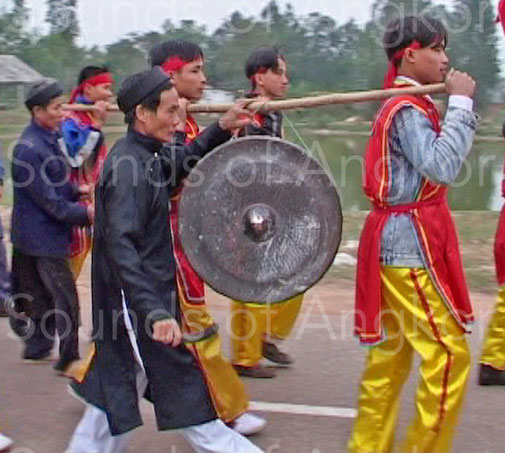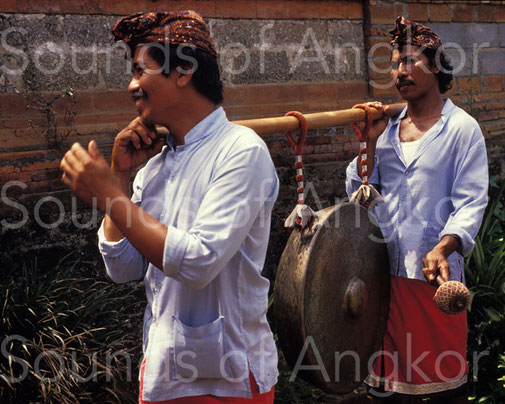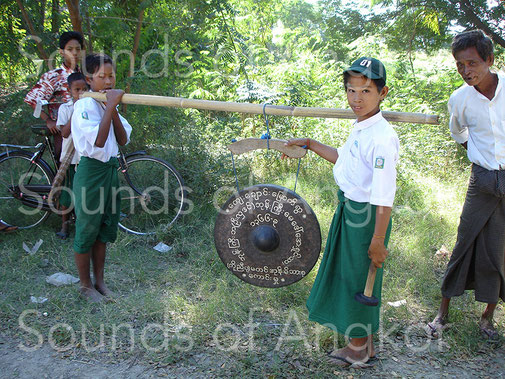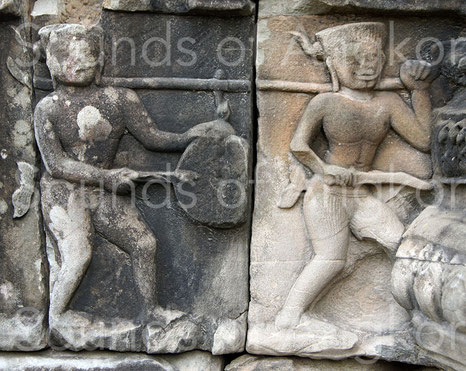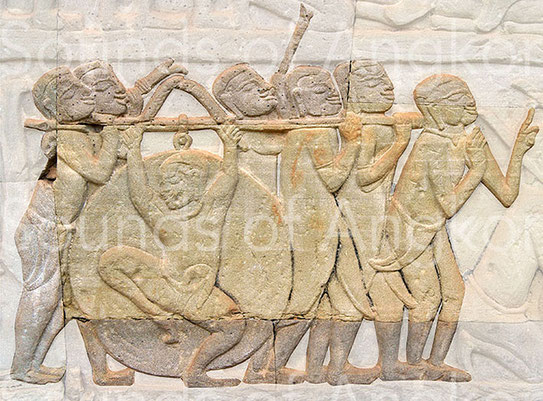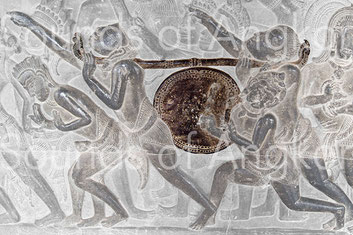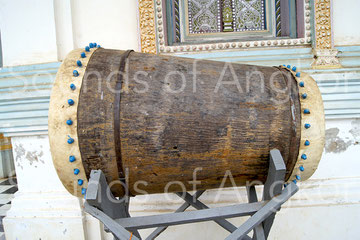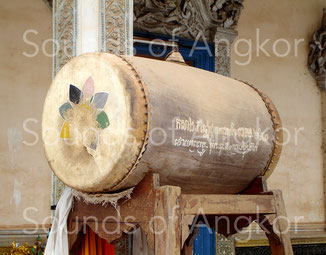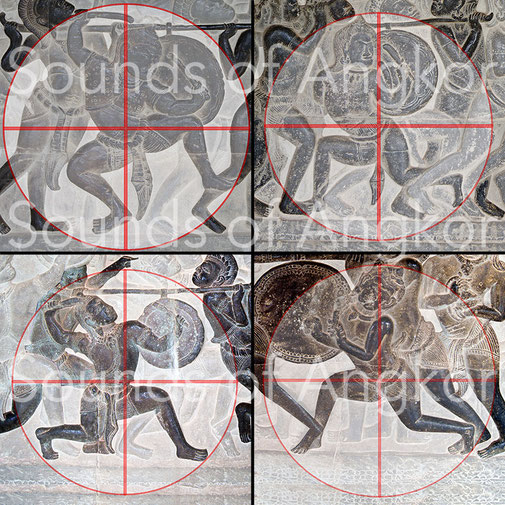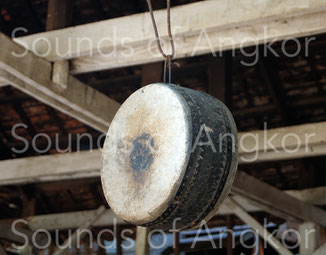Last update: December 5, 2023
If there is a mistake that has been made many times by the authors who have described the sound instruments in the bas-reliefs of the temples of Angkor Wat, Bayon and Banteay Chhmar, it is indeed about the large shoulder carried drum. Their precise nature, it is true, is truly indefinite because of their angle of representation, from the front, on the membrane side. If we refer to all the large drums known in Southeast Asia, their shape varies: cylinder, barrel, truncated cone, hourglass, frame... This is the reason why we call them "large shoulder carried drum" rather than by a terminology relative to their shape as it is usual in instrumental organology. The authors of the past and the guides officiating at the Angkor sites present these instruments as gongs, which is impossible in several aspects.
Gong or drum?
In Southeast Asia, there are two main families of gongs: flat gongs and bossed ones. Flat gongs are played as a unit in many Asian societies or in ensembles (from 2 to N) by ethnic minorities living on the borders of Cambodia, Laos, Vietnam and by some ethnic groups in Malaysia, Indonesia and the Philippines. With few exceptions, flat gongs are played alongside bossed gongs and one or two barrel drums. Their size does not exceed sixty centimeters in diameter, except among the Êdê of Vietnam where the char gong reaches one meter. In South-East Asia, the gongs present in processions almost always have a nipple. However, this nipple is never represented on the bas-reliefs of the Angkorian period in the strict sense of the term, despite all the care taken by the sculptors. Bossed gongs are only visible on the bas-reliefs of the northern gallery of Angkor Wat carved in the 16th century.
The processional gongs are always struck with a single mallet or even a flexible stick, but never (or very rarely due to cultural loss) with a stick. Moreover, the striking is delicate, which doesn't prevent it from being effective. Now, on the bas-reliefs, the drummers are represented with two sticks and strike the instrument with vehemence. Such an ardor can only be heard on a large drum as is still the case today in the Buddhist pagodas and during the processions. To strike in such a way a gong would damage it and would be nonsense. The first large shoulder carried drum appeared in iconography in the 11th century in Baphuon. In the case of this representation, let us admit that there is a doubt as there is no way to lean for one or the other solution, gong or drum, except the single point of attachment consisting of a hook and a ring. Note that the bearing seems to consist of a bamboo whose rhizome has been preserved in the back.
If one refers to contemporary drums, survivals of those of the ancient Khmer, the suspension device consists of an iron ring under which a half-sphere of wood hides the inverted U-shaped stem that plunges into the drum and hang on to it.
Some instruments have, on their periphery, small dots that do not correspond to any known decoration on the gongs both old and current. They represent the nails of wood, bamboo or metal that keep the skin stretched, a technology still topical.
In order not to turn on itself, the gong must be pierced by two longitudinal holes and not transversal. But a single point of suspension appears. It can therefore be deduced that this is a large drum barrel-shaped, cylindrical, truncated such as are still to be found today in the Buddhist pagodas throughout Southeast Asia, or a frame drum.
On the sculptures, drummers strike with two sticks while bossed gongs players have only one mallet to strike one gong or two when there play two gongs. Moreover, the suspension of the gongs suggests a link passing on either side of the bearing and forming an inverted V or U.

On the opposite bas-relief (north gallery of Angkor Wat, 16th century), are staged, left a drum and right two bossed gongs. The drummer strikes with vehemence while the gongs player seems quiet. The latter holds two mallets of different sizes in correspondence with each gong. On the other hand, the posterior carrier holds the gong's carrying link with his left hand to prevent it from turning on itself and limiting its oscillation. In any of the bas-reliefs of the Angkorian period, such a detail doesn't appear, which supports the thesis once again.
Playing positions
In the great scene of the Battle of Kurukshetra - south gallery of Angkor Wat - several drummers hit large drums. All belong to a circle. The sculptor's challenge required showing both the drum and the drummer while giving an impression of power. It is also noted that the center of the circle passes substantially through the hara or center of energy, situated between the navel and the pubis. It is at this point that the percussionist finds the energy necessary for a powerful strike. The positions are somewhat acrobatic and difficult to represent. This is probably why, on the temples of Bayon and Banteay Chhmar, sculptors preferred to represent drummers in the form of characters of abnormally small size, without however presenting the pathologies of dwarfism characterizing many characters of the Elephant Terrace. In the 16th century, when the bas-reliefs were made in the north gallery of Angkor Wat, there were some representations of drummers of normal size, but without regaining the brilliance of Angkorian stylistic dynamism.
Should we see in this circular representation of the 12th century a symbolic aspect? Perhaps. The barrel of the drum is circular and the tambourine represented in a circle. The sound propagates concentrically. The power of the sovereign also extends in a concentric manner. The large shoulder carrying drum is the instrument that emits the loudest sound. It symbolizes the power of the sovereign, his military power. The energy provided by the drummer, symbolically that of the sovereign, is supposed to galvanize the warriors and frighten the enemy.
In most cases, the tambourine does not carry the instrument. With a few exceptions, the later carrier himself hits the drum. The instrument was then probably of a more modest size.
In contemporary Buddhist monasteries, the drums are placed on stands or suspended at a height allowing a powerful striking with the hands at the height of the face, a combination combining comfort and efficiency.

Pagoda drum both suspended and standing on a support. The monk hit it with a single stick to invite the monastic community to pray. For the anecdote, this drum is not a monoxyl one but consists of a juxtaposition of staves. This is in fact the re-use of a barrel of Henessy brand dating from the French colonisation. Wat Bo, Siem Reap.
Profile of sticks
The playing sticks are all represented with an ergonomic curvature. It allows not to alter the skin of the drum and to retain the same striking surface whatever the position of the drummer. Contemporary sticks are in all respects similar.

Large drum on support
The bas-reliefs of the 16th century of the north gallery of Angkor Wat (16th century) have large drums equipped with an integral support. They are still known today in Cambodia. They have various names according to their use: skor yeam, skor peiry, skor chey. On the battlefield, the drum was moved to a carrier, but when the carriers stopped, the instrument was protecting by its support. Again, the angle of representation doesn't augur either the exact profile or the length of the instruments. However, given the ethnology and size of the drums represented, these are most likely barrel drums.



